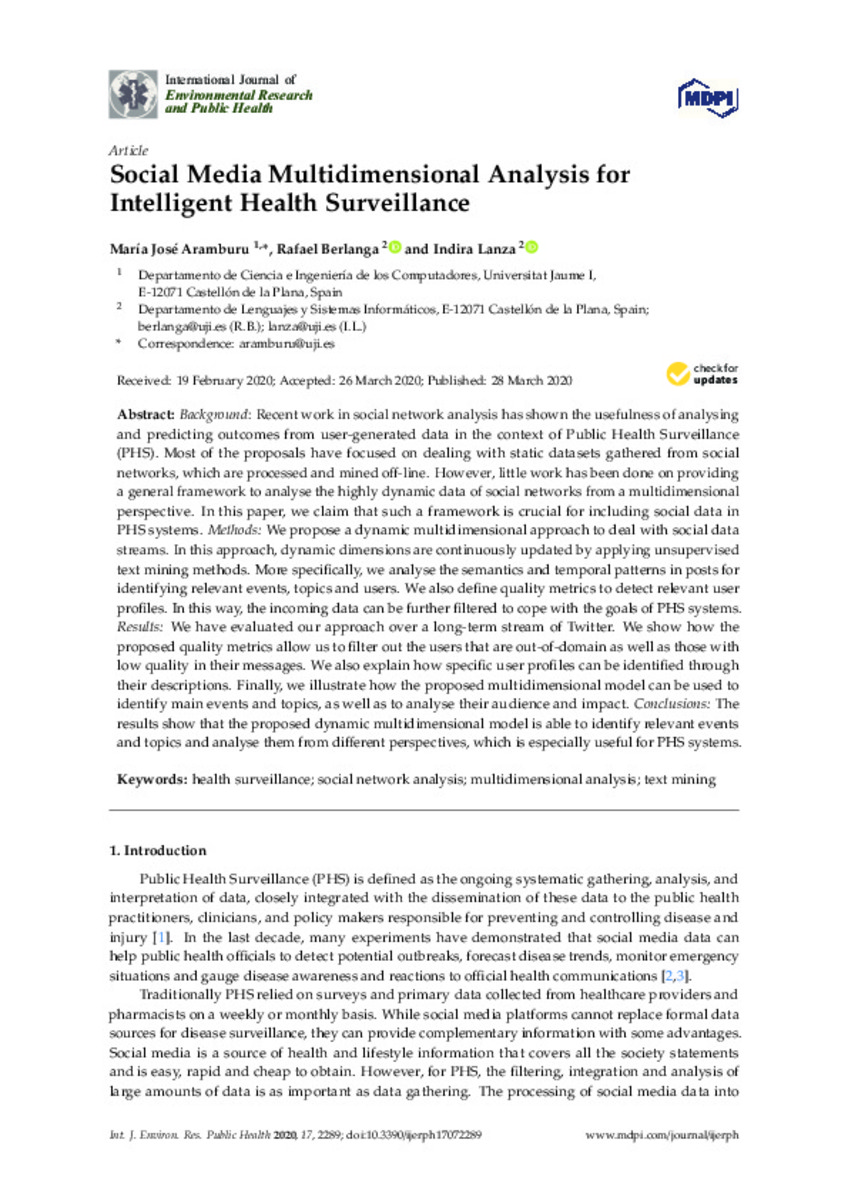Mostrar el registro sencillo del ítem
Social Media Multidimensional Analysis for Intelligent Health Surveillance
| dc.contributor.author | Aramburu Cabo, María José | |
| dc.contributor.author | Berlanga Llavori, Rafael | |
| dc.contributor.author | Lanza Cruz, Indira Lázara | |
| dc.date.accessioned | 2020-09-08T11:24:10Z | |
| dc.date.available | 2020-09-08T11:24:10Z | |
| dc.date.issued | 2020-03-28 | |
| dc.identifier.citation | ARAMBURU, María José; BERLANGA, Rafael; LANZA, Indira. Social Media Multidimensional Analysis for Intelligent Health Surveillance. International Journal of Environmental Research and Public Health, 2020, 17.7: 2289. | ca_CA |
| dc.identifier.uri | http://hdl.handle.net/10234/189590 | |
| dc.description.abstract | Background: Recent work in social network analysis has shown the usefulness of analysing and predicting outcomes from user-generated data in the context of Public Health Surveillance (PHS). Most of the proposals have focused on dealing with static datasets gathered from social networks, which are processed and mined off-line. However, little work has been done on providing a general framework to analyse the highly dynamic data of social networks from a multidimensional perspective. In this paper, we claim that such a framework is crucial for including social data in PHS systems. Methods: We propose a dynamic multidimensional approach to deal with social data streams. In this approach, dynamic dimensions are continuously updated by applying unsupervised text mining methods. More specifically, we analyse the semantics and temporal patterns in posts for identifying relevant events, topics and users. We also define quality metrics to detect relevant user profiles. In this way, the incoming data can be further filtered to cope with the goals of PHS systems. Results: We have evaluated our approach over a long-term stream of Twitter. We show how the proposed quality metrics allow us to filter out the users that are out-of-domain as well as those with low quality in their messages. We also explain how specific user profiles can be identified through their descriptions. Finally, we illustrate how the proposed multidimensional model can be used to identify main events and topics, as well as to analyse their audience and impact. Conclusions: The results show that the proposed dynamic multidimensional model is able to identify relevant events and topics and analyse them from different perspectives, which is especially useful for PHS systems. | ca_CA |
| dc.format.extent | 17 p. | ca_CA |
| dc.format.mimetype | application/pdf | ca_CA |
| dc.language.iso | eng | ca_CA |
| dc.publisher | MDPI | ca_CA |
| dc.rights | Atribución 4.0 Internacional | * |
| dc.rights.uri | http://creativecommons.org/licenses/by-sa/4.0/ | * |
| dc.subject | health surveillance | ca_CA |
| dc.subject | social network analysis | ca_CA |
| dc.subject | multidimensional analysis | ca_CA |
| dc.subject | text mining | ca_CA |
| dc.title | Social Media Multidimensional Analysis for Intelligent Health Surveillance | ca_CA |
| dc.type | info:eu-repo/semantics/article | ca_CA |
| dc.identifier.doi | https://doi.org/10.3390/ijerph17072289 | |
| dc.relation.projectID | the Spanish Ministry of Industry and Commerce (grant numberTIN2017-88805-R) ; Universitat Jaume I (pre-doctoral grant PREDOC/2017/28) | ca_CA |
| dc.rights.accessRights | info:eu-repo/semantics/openAccess | ca_CA |
| dc.relation.publisherVersion | https://www.mdpi.com/1660-4601/17/7/2289 | ca_CA |
| dc.type.version | info:eu-repo/semantics/publishedVersion | ca_CA |
Ficheros en el ítem
Este ítem aparece en la(s) siguiente(s) colección(ones)
-
LSI_Articles [362]
Articles de publicacions periòdiques escrits per professors del Departament de Llenguatges i Sistemes Informàtics -
ICC_Articles [423]








